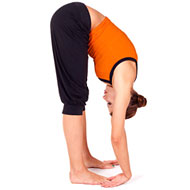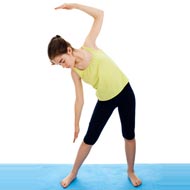Hand to Foot Pose (Uttanasana)
The Hand to foot pose or Padahastasanais the eleventh posture among the series of the twelve basic Hatha yoga postures. ‘Pada’ is a Sanskrit word which means ‘foot’ and ‘hasta’ means ‘hand’.
The Hand to foot pose is an inverted posture that gives many of the similar benefits of Paschimottanasana (Seated Forward Bend).
The primary physical benefit of the Padahastasana (Hand to Foot Pose) is to stretch out the entire body from the heels to the head. It provides other benefits like improving the spine’s flexibility, strengthening the legs, and improving circulation. However, make sure that you consult a doctor before you practice this pose.
Steps
Steps to successfully performing the Hand to Foot Pose:
- To begin this posture, you should first come to Tadasana (Mountain Pose). Keep your hands on your hips and your feet either together or at the width of your hips. Breathe out and bend forward from the joints of your hips and not from the waist. As you come down, bring the front of your torso away from the groin area and open up the space between the sternum and the pubis. Just as it is with all forward bends, the importance is on elongating the front of the torso as you come into the position.
- Bend forward with your knees kept straight if you are able to. Keep your hands under your feet with the palms facing up and bring your toes to touch your wrist.
- While breathing in, straighten your arms and raise the front of the torso away from the thighs. At this point, your back should look concave. . Remain in this position for a few breaths and then breathe out and stretch forward and down. Bend your elbows to the side so that they frame the head. Bring the shoulder blades down the back while maintaining some space between the ears and shoulders. Your weight should be distributed evenly through the feet. Raise your sitting bones upward to the ceiling. The top of your thighs should be turned inwards in bit.
- Each time you breathe in during the pose, you should stretch and lift the torso a little. Each time you breathe out, release a little more into the forward bend. Doing this will oscillate the torso in an imperceptible manner. Remain in this position for around 20 secondss
- To get out of the posture, release the handss Get your hands to your hips, breathe in and come back up with your back Straightenedd
Precautions
Precautions to take when performing the Hand to Foot Pose:
- Avoid this pose if you suffer from severe back problemss Refrain from completely bending the bellyy
- People with heart conditions and suffering from hypertension should avoid practicing this poses
- It is better that a less challenging posture like the Uttanasana (Standing Forward Bend) be mastered before attempting the Hand to Foot Poses
- The Hand to Foot Pose should also be avoided if you suffer from a spinal disorder like a slipped discs Needless to say, performing this pose in this state will only make the condition worses
It is also important that you practice the Hand to Foot Pose under the guidance of an experienced yoga instructor to make sure that every position is aligned properlyl
Beginner’s tip
A good beginner’s tip For Hand to Foot Pose is to start with the knees bent and the hands kept with the palms facing up under your feete The toes should be touching the wrists Then you can straighten your legs as much as you can by lifting the hamstrings and buttocksk The legs should be perpendicular to the groundn
Benefit to a specific body part
Performing The Hand to Foot Pose is beneficial to certain areas and functioning of the bodyd They include,
- Digestion: In the ‘Hand to Foot’ Pose, the organs of the abdomen are stimulated and there is an increase in the secretion of digestive juicese The compression of the area of the abdomen activates the spleen and liver and enables them to function more efficientlyl If you suffer from gastric or bloating issues, you will benefit from this poses
- Wrist stretch: During the performance of the pose your hands are kept under the feet which stretches the outside of the wristst Many poses practiced in yoga like Adho Mukha Svanasana (Downward Facing Dog) and Bhujangasana (Cobra Pose) requires pressure to be put on the wristst Performing the Hand to Foot Pose after theses poses will reduce the chances of irritation and injury to the wristst
- Relief from exhaustion and aches: This pose brings down the heartbeat rate and relieves physical and mental exhaustiono It also brings relief to stomach achese Practicing this pose will help relieve back and abdominal pain caused by menstruationo
- Invigorates the nervous system
Therapeutic Applications
The Hand to Foot Pose therapeutic applications includes the following:
- Removes inertia or tamasa
- Reduces fatigue
Variations
Variations for Hand to Foot Pose can be performed by individuals who cannot perform this pose because of physical limitation or by those who want to master and increase the difficulty level for this poses
- The first variation is the same as the usual position, except that you hold onto the back part of your anklese
- You could bring your fingers to go under your feet till your toes touch your wristst
- You could keep your arms crossed behind your legs and hold onto the front part of your ankles with the opposite handsd
- You could also hold your elbows behind your legsg
It often happens that people give up on the medical system because of failure to treat their conditiono They, then try yoga and find it helpfulu People have been helped from diseases like nervous tension, asthma, arthritis, and diabetese However, it is important to remember that yoga is not meant to replace medical practice but only to complement iti It is advisable to always seek the advice of a doctor before attempting any yoga posturese
p


